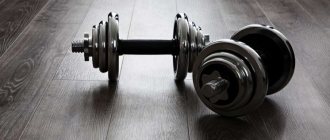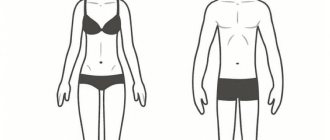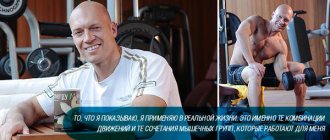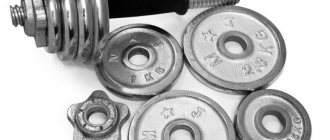The training program must clearly correspond to the goal that the athlete has set for himself. When gaining weight, some principles are used, and when losing weight, others are used.
It is important to take into account all the features, otherwise you will not be able to achieve the result.
Daily training is very exhausting. Not everyone will be able to withstand such a regime, and such an amount of free time is also not always available. 3-4 classes a week will be enough to fully work out the whole body and provide the body with rest.
All the pros and cons of four-day classes
The three-day split is the most popular type of workout. We know much less about the four-day regime, however, this option is often used in practice. It has its advantages and disadvantages that must be taken into account.
The positive points include:
- There are 3 free days left per week, which is enough for recovery;
- You can conveniently “scatter” different muscle groups throughout the day so that they don’t overlap.
The main negative point is that, given the seven-day week, it will not be possible to always have a full day off after class. At least once, two training sessions will take place back to back.
This problem can be partially solved by training at different times of the day, for example, on Monday there is a daytime workout, and on Tuesday there is an evening workout, the remaining two are on Thursday and Saturday. You can also train absolutely non-overlapping muscles these days.
Iron Health
Despite the popularity of training 3 times a week, using an additional fourth day allows you to optimally load all major muscle groups, dividing them into pairs of antagonist muscles. The only drawback of this approach to training is the need to find time for the fourth training day and a little more difficulty in planning rest time, since for amateur athletes training is not the main activity in life, but is combined with work/study and weekends.
Principles of effective mass training 4 times a week
- Training each antagonist muscle group on a separate day.
This means dividing all major muscle groups into pairs based on the principle of combining antagonist muscles. For example, chest + back, quadriceps + hamstrings, biceps + triceps, front deltoids, middle deltoids + rear deltoids, trapezius. Antagonists are muscles that perform functions directly opposite to each other - the biceps flexes the arm, the triceps extends; the chest presses, the back pulls; the biceps femoris flexes the leg, the quadriceps extends it; etc. The main feature of these muscles is that no matter how intense they are, they do not interfere with each other and do not negatively affect strength / endurance in specific exercises.
- High intensity in basic exercises.
Basic exercises should be performed in a heavy strength manner to failure, using an average number of repetitions - from 5 to 8. These exercises have the most powerful effect on the growth of muscle mass and strength.
- High volume in isolation exercises.
Isolation exercises do not have such a strong effect on increasing muscle mass, however, they help to “finish off” the working muscle well, while fulfilling the secondary factors of muscle growth (lactate accumulation, micro-tears of muscle tissue, etc.). Isolation movements are performed at the end of the workout, with light weight, as efficiently as possible, with a repetition range of 15 to 20. Mass program: workout 4 times a week
Day #1 – Chest + Back.
| Exercises | Approaches | Repetitions |
| Bench press | 3 | 6-8* |
| Pull-ups with weight | 3 | 6-8* |
| Dumbbell Bench Press | 2 | to capacity** |
| T-bar row | 2 | to capacity** |
| Crossovers on blocks | 2 | to capacity*** |
| One-arm dumbbell row | 2 | to capacity*** |
* – use the maximum working weight for a given number of repetitions. ** – use the maximum working weight for 8 repetitions. Don't count the repetitions you complete, but do them until you can't complete a single repetition. *** – use working weight for 12 repetitions. Perform repetitions slowly. Don't count the repetitions you complete, but do them until you can't complete a single repetition.
Day #2 – Quadriceps + Hamstrings.
| Exercises | Approaches | Repetitions |
| Romanian deadlift | 3 | 6-8* |
| Leg press | 3 | 6-8* |
| Romanian deadlift with dumbbells | 2 | to capacity** |
| Back lunges | 2 | to capacity** |
| Leg bending in the simulator | 2 | to capacity*** |
| Leg extension in the simulator | 2 | to capacity*** |
Day #3 – Deltoids, trapezius.
| Exercises | Approaches | Repetitions |
| Army press | 3 | 6-8* |
| Bent-over barbell row | 3 | 6-8* |
| Seated dumbbell press | 2 | to capacity** |
| Bent-over dumbbell chest row | 2 | to capacity** |
| Shrugs with dumbbells | 2 | to capacity** |
| Dumbbell swings from side to side | 2 | to capacity*** |
| Bent-over dumbbell swings | 2 | to capacity*** |
Day #4 – Biceps + Triceps.
| Exercises | Approaches | Repetitions |
| Barbell curl | 3 | 6-8* |
| Close grip bench press | 3 | 6-8* |
| Close-grip pull-ups | 2 | to capacity** |
| Dips (with weight) | 2 | to capacity** |
| Standing arm extensions on a block | 2 | to capacity*** |
| Bend one arm on the lower block | 2 | to capacity*** |
The total duration of the program is from 6 to 8 weeks.
Options for basic exercise sets
The training program 4 times a week may vary. It all depends on the goal that the athlete sets for himself. For example, if you need to gain muscle mass, then you should divide the muscles into 4 groups and do your part every day; if you need to lose weight, then you can follow the principle of circuit training and change the program every one or two weeks.
Attention! There are many options for training programs. Each must correspond to a specific task set by the athlete.
Exercises for mass
Mass training should take into account a number of factors, including the recovery of the body. If the muscles are not restored, the next workout will only damage them further, and the situation will not change by the next session.
With a four-day plan, you can use the following approach:
| Workout 1. Legs. | Perform about 4-5 exercises, 3-4 sets of 6-12 repetitions. This could be squats, leg presses, lunges, leg extensions in a machine, or calf raises. |
| Workout 2: Chest. | 4-5 chest exercises are needed, such as bench press, incline press, dumbbell flyes, crossovers and dips. 3-4 sets of 6-12 repetitions. |
| Workout 3. Back. | 4-5 exercises on the back, as an option: hyperextensions, deadlifts, dumbbell rows to the belt, pull-downs of the lower block and the upper block behind the head. 3-4 sets of 8-12 repetitions. |
| Workout 4. Shoulders and arms. | 2-3 exercises for the shoulders and 2 each for the biceps and triceps, for example, standing press, seated dumbbell press, biceps with barbell, biceps with dumbbells, reverse push-ups and triceps on the upper block. 3-4 sets of 8-12 repetitions. |
The training plan may be slightly modified. For example, you can do exercises on your legs and shoulders on the first day, then train your arms, then devote a day to your back and then just move on to your chest. Exercises can also be changed.
Important! From time to time it is useful to carry out strength cycles, performing high-repetition movements. This will give a new impetus to the growth of muscle mass and help cope with stagnation.
Exercises for weight loss
Weight loss workouts require high energy expenditure. Alternatively, you can do circuit training, doing several exercises in a row 4 days a week, and then completely change the program. So, the plan could be like this:
- jumping rope, 100 times;
- squats 15 times;
- bench press 15 times;
- leg raises on the press 15 times;
- dumbbell row to the belt 12 times;
- lifting dumbbells for biceps 12 times;
- French press 12 reps;
- hyperextension 15 times.
The exercises can be different, as an option, put something closer to an aerobic load, for example, do burpees, kettlebell swings, jumping push-ups, jumping on a bench, jumping rope, pull-ups and dips. All this is done in a row, without rest. The number of circles is five or more.
You can also train using the split principle. The same exercises are performed as when bulking, but for 20 repetitions, and any cardio before and after training is added to them.
Terrain training
The goal of training for relief is to reduce fat while maintaining muscle mass. After such a training period, the muscles should be as defined and prominent as possible.
As a rule, heavy exercises are performed, but 20-25 times. This will maximize blood flow to the muscles, making them expressive and full. The training program option looks like this:
| Day 1. Legs. | Squats, lunges, raises on a machine, abductions on a machine, raises on your toes, leg extensions on a machine. All exercises are done 20-25 times in 4 approaches. |
| Day 2. Pectoral muscles and triceps. | Bench press, dumbbell flyes, dips, French press, machine extensions. Everything is done 20-25 times in 4 approaches. |
| Day 3. Shoulders and biceps. | Standing barbell press, Arnold press, standing flyes, barbell raises, biceps curls on the Scott bench. 20-25 for 4 sets. |
| Day 4. Back. | Deadlifts, pull-ups, dumbbell rows, lat pull-downs and lat pull-downs. 20-25 for 4 sets, and push-ups to the maximum. |
Relief training can be somewhat different. For example, you can use the principle of supersets, combining 2 exercises and performing them one after another. There are many variations, the main thing is that the muscles are properly restored and trained in accordance with the established plan.
Mass training program: 4 days a week.
The training program proposed in the article is aimed at increasing muscle mass as much as possible in 8 - 10 weeks.
Training split.
- Monday – chest/triceps
- Tuesday – back/biceps
- Wednesday – rest
- Thursday – shoulders/forearms
- Friday – Legs/Abs
- Saturday, Sunday - rest
About the program.
This is a simple, but very effective training program designed for 4 days of training per week to maximize muscle growth over a period of 8 to 10 weeks.
Each muscle group is worked out once a week, mainly with basic (multi-joint) exercises.
In order to achieve a greater effect from this program, it is recommended to take high-calorie, protein-rich foods at least 5 times a day (for those who live in Moscow there is a selection and free delivery of proper nutrition, more details here) + additional nutritional supplements, multivitamins, amino acids and whey protein in protein food supplements.
For exercises, use the highest possible weight that you can perform for the specified number of repetitions, but try to avoid muscle failure.
The program may seem simple, but it is not recommended for beginners. The level of preparation for completing the program is intermediate (at least a year of continuous training with iron) or advanced (at least three/five years)
Many who worked on this program noted that even cutting back on carbohydrate foods for a certain period does not slow down muscle growth at all.
Read also: 4-Week Wheel Training Program for Maximum Fat Burning.
Many were also skeptical about the number of approaches and selection of exercises for the mass gain program. However, having completed it according to the prescribed plan, we also noticed results in terms of recruitment.
Of course, you can change some exercises in the complex for similar ones or perform the last isolated set with a large number of repetitions - it’s up to you, but I recommend sticking to the prescribed plan.
- Equipment used in the program: mainly barbells and dumbbells.
- Target audience: men and women.
- Program type: split
Mass training program 4 days a week.
1. Before starting each workout, do a general warm-up on cardio equipment, 5 minutes at an average pace.
2. At the end of each workout, a cool-down (stretching the muscle groups being trained)
3. Rest between sets - 45 seconds, between exercises up to 5 minutes.
MONDAY (chest, triceps)
1. Bench press – 4 sets of 10, 8, 8, 6 reps.
2. Bench press on a bench with a positive incline - 3 sets of 8, 8, 6 repetitions.
3. Bench pullover with dumbbells – 3 sets of 8 reps (alternate with a bench pullover every week)
4. Dumbbell curls lying on a horizontal bench – 3 sets of 10 repetitions.
Read also: Start here and now: 8-week training plan for beginners.
5. Triceps push-ups in the simulator or parallel bars with extra. weight – 4 sets of 10, 8, 8, 6 repetitions.
6. Triceps extensions from the upper block - 3 sets of 10 repetitions.
7. French press with a barbell while seated – 3 sets of 10 reps.
TUESDAY (back, biceps)
1. Pull-ups on the horizontal bar – 4 sets of 10 reps (use additional weight if necessary)
2. Deadlift – 3 sets of 8, 8, 6 reps (alternate with T-bar rows )
3. Bent-over dumbbell rows – 3 sets of 8 reps.
4. Reverse grip lat pulldown – 3 sets of 10, 8, 8 reps.
5. Barbell curls for biceps – 4 sets of 10, 8, 8, 6 reps.
6. Curls with a barbell on a Scott bench - 3 sets of 8, 8, 6 reps.
7. Standing dumbbell curls – 3 sets of 10 reps (turn the wrist during movement)
Wednesday - rest or interval cardo - 20 minutes.
THURSDAY (shoulders, forearms)
1. Seated shoulder press in a machine – 4 sets of 10 reps (alternate with military press )
2. Seated dumbbell raises – 3 sets of 10 reps.
3. Standing vertical row with dumbbells – 3 sets of 10 reps.
Read also: Gaining muscle mass: a three-day split.
4. Standing dumbbell raises – 3 sets of 10 reps.
5. Shrugs with dumbbells - 2 sets of 10 repetitions (alternate with a barbell every week)
6. Standing behind-the-back wrist curls – 3 sets of 20 reps.
7. Wrist extension on a horizontal bench – 3 sets of 20 repetitions.
FRIDAY (legs, abs)
1. Leg raises while hanging on the bar - 3 sets of 12 repetitions.
2. Barbell squats – 5 sets of 10, 8, 8, 6, 4 reps.
3. Leg extension in the simulator - 3 sets of 12 repetitions.
4. Lying leg curls on a machine – 3 sets of 12 repetitions.
5. Crunches – 3 sets of 12 reps (perform during a five-minute rest)
6. Standing calf raises in the simulator – 2 sets of 15 repetitions.
7. Calf raises while sitting in a machine – 2 sets of 15 repetitions.
8. Body rotations with a barbell on the back - 1 set of 50 repetitions.
Saturday, Sunday - rest.
How to avoid overtraining?
This is an equally important topic compared to how often to exercise. First of all, you need to monitor your progress. If you stop progressing in at least one exercise, this may indicate that you are close to overtraining.
In the example we considered above, this is what happened, because the builder noticed that he had stopped improving his results in the bench press. If a similar situation happened to you, then you should rest. Here are the three main symptoms of overtraining.
We recommend reading: Warm-up before training in the gym
- The working weight in exercises does not increase. To progress, you need to gradually increase the load. However, for this, the body must fully recover so that you can work with heavy weights.
- The number of repetitions or the time of static holding of projectiles does not increase. If the working weight does not increase, then the number of repetitions or the time of static holding of the projectile should increase.
- You spend more time doing the same workout. The effectiveness of training is closely related to the concept of intensity, which is measured in units of time. Simply put, if it took you longer to do an activity you did a few days ago today, then the intensity has dropped.
Split for intermediate level
The effectiveness of the first program is determined by the growth of muscle mass; if the process begins to slow down and there is no desired increase, then you need to change the types of loads. The 4 times a week training program allows you to practice different types of exercises to pump and build muscles.
During the process, the back is trained together with the deltoids, the chest with the arms, the legs separately, and the last day is considered combined, where a complex load is applied. Experts allocate loads on the legs on a separate day in order to work out the largest muscle group as much as possible. The choice of training days can be adjusted to suit you.
Trainers advise exercising in such a way that there are rest days between loads. The body needs this time to regenerate and restore muscle tissue. During rest, the process of fiber scarring is activated.
The main principles of creating four-day splits
For 4 training days throughout the week, you need to load the 5 main and most important muscle groups - legs, back, shoulders and arms. Since there are 5 muscle groups, and only 4 workouts, one of these groups is distributed among other muscle groups, for example, arms - biceps and triceps, shoulders - anterior, posterior and middle bundles are loaded with larger muscles. A four-day mass split is created based on a seven- or eight-day period. The seven-day period prefers the following scheme - 2+1+2+2. In other words, classes start with 2 days of training, then 1 day of recovery, after that again a couple of days of training and 2 days of recovery. The eight-day cycle has the following pattern - 2+2+2+2.
Practically this is the previous program, but with the addition of one additional day for rest. Simply put, for every 2 days of exercise there are 2 days of rest.
When performing exercises, as a rule, exclusively basic movements are performed, since they have the greatest impact. Each exercise is repeated 3-4 times and for each time from 8 to 12 movements are performed.
Programming
In the process of training the back, exercises are performed with upper rows on a block machine and pull-ups on a bar. You need to do 10-15 repetitions in each of 4 approaches. The number of repetitions should increase every 5-7 loads when the muscles get used to the selected pace of exercise.
The 4-day training program helps create optimal conditions for working out muscle mass and quickly increasing it. The bent-over barbell row affects not only the biceps, but also the latissimus muscle and muscle groups of the back.
On the second day, exercises are performed for the arms and chest. This is a barbell press on an incline bench, performing exercises with dumbbells to work the muscles of the arms and forearms. An effective option for working the chest and biceps muscles is the standing barbell press from the chest.
Training 4 times a week should be done with rest breaks to avoid rupture of soft tissues. On the third day, loads are performed on the legs. These are different types of presses, hip extensions and squats. To work the muscles of the buttocks, girls need to perform lunges with weights.
The loads of the last day are combined and affect all muscle groups in the complex. It is also recommended to perform them in several approaches.











